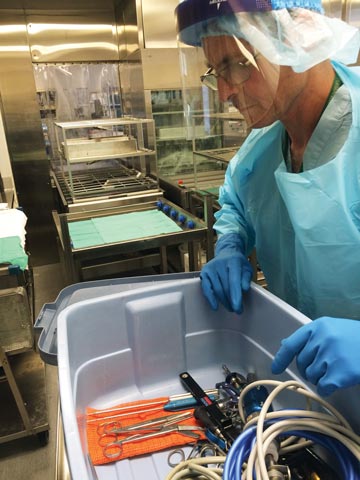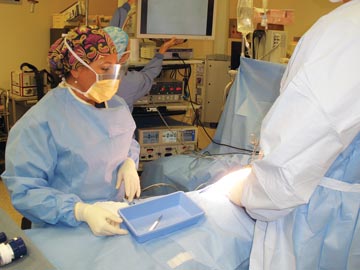2. Sharps safety extends beyond the OR. Sharps injuries can occur when and where you least suspect them, not just within the confines of the OR walls, but wherever people use, dispose of, disassemble and disinfect sharps. Year after year, 1 in 4 of all sharps injuries occur downstream to the non-user, according to sharps injury incident data from the International Safety Center Exposure Prevention Information Network (EPINet). "Keep in mind that the use and activation of safety mechanisms and proper disposal protect not just the user of the device, but those who come into contact with that device throughout its lifespan," says EPINet.
In sterile processing, for example, a tech can easily reach his hand into a tray and get poked by a concealed sharp. Jenny Crnkovich, director of central service/sterile processing at Marquette University in Milwaukee, Wis., can still see the number 11 blade glistening at the bottom of the decontamination tray, the elongated, triangular "pointy dagger" ideal for stab incisions still mounted to a number 7 knife handle.
"Nobody wants to touch the tray. You're basically reaching your hand into an incinerator," says Ms. Crnkovich. "You don't know what you're going to touch. The risk of injury is so great, a blade sharpened along the hypotenuse edge with a strong pointed tip making it and precise short cuts in shallow recessed areas.
"We assume everyone is continually capable and continually competent, but people develop bad habits and have a false confidence. Technique lapses, you lose sight of safety aspects of sharps and things happen. So many sharps incidents occur in SPD, but people don't seem to care. We don't always think about the safety of others."
Here's an idea to alert your sterile processing staff to the presence of sharps, courtesy of Christopher M. Lomboy, RN, BSN, RNFA, MBA, perioperative manager at Kaiser Permanente San Jose Medical Center Ambulatory Surgery Unit in San Jose, Calif. Repurpose those orange mats you use to designate a neutral zone for the hands-free transfer of sharps to create a sterile processing safe zone. Once the case is over, place knife handles, hooks, drill bits and all other sharps atop the orange mat so that your SPD team knows right away there are sharps in the tray.
3. More than half of incidents are not even reported. It has been estimated about half of sharps injuries go unreported. Do your staff members feel comfortable reporting a stick without fear of retaliation? And do they take sticks seriously?
"We don't treat it with caution and care. If I get poked, I get poked. We don't want to write an incident report today. High reliability is a fierce underlying problem," says Ms. Crnkovich. "No one should be afraid to report they got stuck."
.svg?sfvrsn=be606e78_3)


.svg?sfvrsn=56b2f850_5)